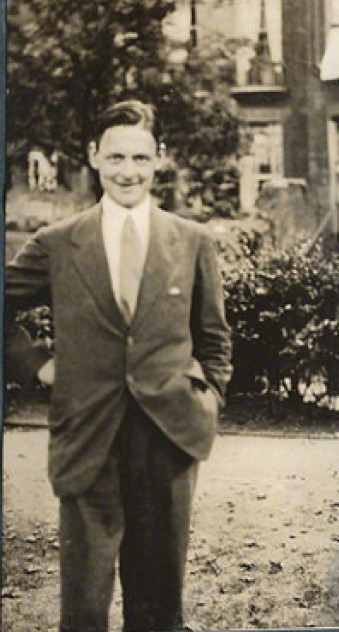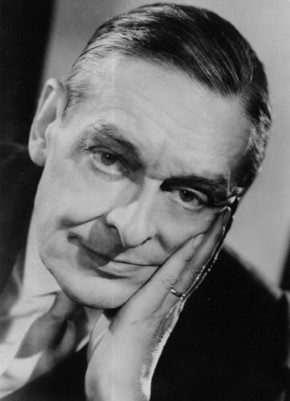
Eliot, T S (Thomas Stearns Eliot)
‘The poet’s mind is in fact a receptacle for seizing and storing up numberless feelings, phrases, images, which remain there until all the particles which can unite to form a new compound are present together’ (T S Eliot, The Use of Poetry) Thomas Stearns Eliot was born in St Louis, Missouri and, while he was raised in the South, extended summers were spent with relatives in New England. Eliot’s grandfather had moved from Massachusetts, the regional hub of New England, to Missouri, to establish a Unitarian church. The Eliot family had a distinguished heritage and were able to trace roots back to the founding of the Massachusetts Bay Colony. Prominent relatives included a recent president of Harvard University and three presidents of the United States – John Adams, John Quincy Adams and Rutherford Hayes.Eliot was conscious of his own family history and felt the weight of the past impinging on the present. He struggled with his identity, noting that he ‘had always been a New Englander in the South West, and a South Westerner in New England’. In later life he would relish the role of outsider, distancing himself from America and embracing British citizenship.
Eliot completed his secondary education at the Smith and Milton academies in Saint Louis, before relocating to Massachusetts to attend Harvard University. Eliot travelled to Oxford University to undertake further research for his Harvard doctorate. He is known to have commented that he ‘liked Aristotle, disliked Oxford’. While in England, Eliot abandoned Philosophy to pursue poetry. In marrying Vivien Haigh-Wood in 1915, Eliot committed to her to demonstrate his commitment to England. Eliot’s family disapproved of his wife and his new vocation as a writer.
Key work: ‘The Waste Land’ (1922)
Eliot commented on the ravages of war across Europe. Following the end of the First World War in 1918, nine million were dead, with dynasties and political parties disintegrating in several countries. Eliot saw an effect of the violent upheaval as a collapse of culture and history. He continued exploring this idea in his larger work ‘The Waste Land’. Written between 1919 and 1921, and published in the inaugural issue of The Criterion in 1922. Eliot juxtaposed the ordered world of myth with the chaos of modern history. He weaved in references to myth in a poem with shifting perspectives. The personal and political intertwined as the poem addressed death, civilisation, and potential for rebirth and restoration. Throughout the poem connections are made between sexuality and violence.
In writing ‘The Waste Land’, Eliot also drew on his own personal struggles: the breakdown of his marriage, estrangement from America and his family, who disapproved of his marriage, and abandonment of academic studies in Philosophy. The modernist writer Virginia Woolf felt Eliot’s personal life had a direct influence on his writing: ‘He was one of those poets who live by scratching, and his wife was the itch’.
Eliot defended ‘The Waste Land’ from criticisms of chaotic form, arguing ‘There is a logic of the imagination’. He went on to reject the mantle of spokesperson of a generation:
Various critics have done me the honour to interpret the poem in terms of criticism of the contemporary world, have considered it, indeed, as an important bit of social criticism. To me it was only the relief of a personal and wholly insignificant grouse against life. It is just a piece of rhythmic grumbling’. Eliot on ‘The Waste Land’
Eliot had set out his views on writing in his 1919 essay ‘Tradition and the Individual Talent’. Literature had an ideal which stretched back to the classical writing of Homer. Eliot was critical of movements such as Romanticism, which celebrated the artist in isolation. He found it was not in contradiction to view text both as an object in itself and an ongoing collaboration with the reader. The balance between novelty and tradition is seen as ‘imaginative sense’.
Eliot objected to the concept of ‘interpretation’, where a reader may regard some element of a text as providing an allegory, which may not be in the poem. He warns critics not to dissect works in relation to the poet. However, he did recognise that the writer would be present in the work. He felt even Shakespeare was occupied with the struggle ‘to transmute his personal and private agonies into something rich and strange, something universal and impersonal’ (Eliot, Selected Essays).
Challenging Elements
There are problematic elements in Eliot’s work. The poems have been found to be misogynistic in the generalisation of women and treatment of females. Prufrock claims he is afraid to speak, yet is given agency and dialogue in his thoughts. In ‘Rhapsody on a Windy Night’, the young prostitute is objectified and overshadowed by the pockmarked moon, personified as an old madam.
Likewise, there is evidence of ingrained anti-Semitic views with derogatory language and stereotypes present in a number of his earlier poems. Eliot wrote to his mother in 1924 noting his own views were becoming ‘reactionary and ultra conservative’, and letters were exchanged with fascist and far-right groups in Europe, although ultimately Eliot rejected these associations.
Beyond difficulties with content and attitudes, some readers find the range and complexity of references in Eliot’s work create a distancing effect. Associations are often inferred. Thomas Fuller suggested that Eliot ‘sails to his goal by a side wind’. Eliot’s work is characterised by irony, symbolism and antithesis. The poems demonstrate lyrical economy, as Eliot was often concerned with what can be left out. Eliot felt that ‘genuine poetry can communicate before it is understood’ (Selected Essays).
Eliot on Eliot
In an introduction to critical essays in 1928, Eliot categorised himself as: ‘Classical in literature, Royalist in politics and Anglo-Catholic in religion’. These potentially contradictory positions seem to reflect his poetic style, which fuses disparate images, references and emotions. He viewed his art as a science, describing poetic elements as ‘particles which can unit to form a new compound’ (Eliot, The Use of Poetry).
Eliot was keen to deny the role of speaker for a generation. He had been drawn to Christianity and was contemplating his own salvation. He had already considered and rejected Buddhism and philosophical models. Ash Wednesday was the first day of Lent and a period of repentance and self-examination. In his earlier works, Eliot sought to make art out of the chaos of history. In the poem ‘Ash Wednesday’, art becomes a means of making life possible.
Eliot believed he treated his subjects in such a way that ‘our own solid, dreary, daily world would be suddenly illuminated and transfigured’ (Eliot, Poetry and Drama, 1951).
There is much in Eliot’s work to engage the modern reader: the psychological discourse of public versus private self; the use of fragments and experimental forms to suggest the disintegration of society; the biting satire that charts the corruption of the modern world; the sensory images that convey the disorder of a world in crisis.
Eliot’s context of writing was a time of great social and political upheaval; our context of reception is a world that continues to lack stability or certainty for many. Students can decide for themselves whether Eliot can still be claimed to be ‘the voice of the modern consciousness’.
Further Reading
© ZigZag Education 2026: content may be used by students for educational use if this page is referenced.
Show / hide details
| 1888 |
Birth
|
|
| 1906 |
The Harvard student
|
|
| 1909 |
European influences
|
|
| 1911 |
Philosopher or poet?
|
|
| 1914 |
Oxford and London
|
|
| 1915 |
Marriage and mourning
|
|
| 1915–19 |
Early employment
|
|
| 1917 |
Prufrock and Other Observations
|
|
| 1919 |
Death and depression
|
|
| 1920 |
Publication of collection of critical essays The Sacred Wood. The poem ‘Gerontion’ also completed.
|
|
| 1921 |
Illness and ‘The Waste Land’
|
|
| 1922 |
The Criterion magazine launched, with ‘The Waste Land’ published in the first issue.
|
|
| 1925 |
Poems 1909–1925
|
|
| 1927 |
Confirmed citizen
|
|
| 1930 |
‘Ash Wednesday’ and ‘Marina’ published.
|
|
| 1932 |
Selected Essays
|
|
| 1935 |
Published collection of poems aimed at children, Old Possum’s Book of Practical Cats.
|
|
| 1942 |
Lecture collection The Music of Poetry.
|
|
| 1943 |
Four Quartets published.
|
|
| 1947 |
Death of Vivien
|
|
| 1948 |
International recognition
|
|
| 1949 |
Popular playwright
|
|
| 1957 |
Later love
|
|
| 1958 |
The Elder Statesman
|
|
| 1965 |
Death
|


